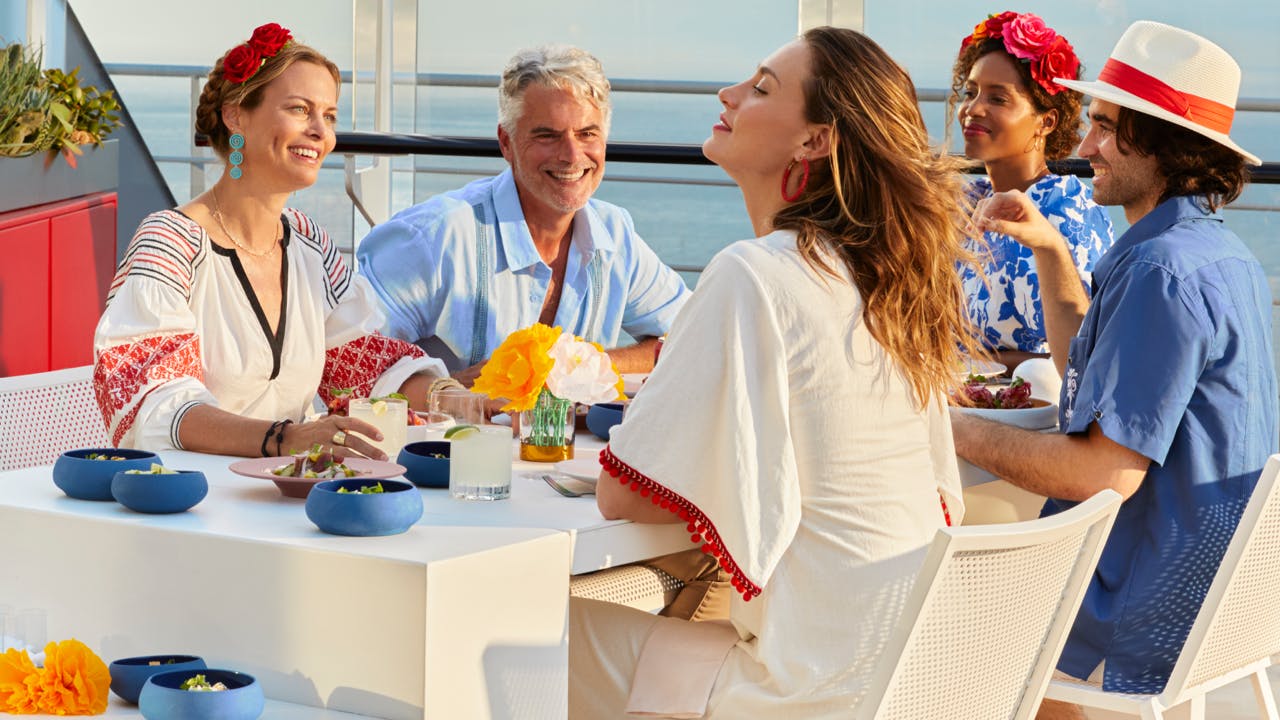
As a Sailor on one of our cruises, there’s some stuff we don’t want you to worry about. Cooking for yourself, for example. Stressing about work. And we certainly don’t want our Sailors to be preoccupied wondering, “how do cruise ships work?” or “no seriously, how do they stay afloat like that?” Our engineers worry about these things so you don’t have to. But even if you’re not contemplating the Archimedes Principle of positive buoyancy while you’re soaking up rays on the pool deck, you might have always wanted to know how cruise ships stay afloat, or how they avoid obstacles at night. These are interesting questions, even for the non-mechanically inclined.
Since we’re in the cruising business, we find this stuff fascinating, too. That’s why we interviewed Chief Engineer Rhea Wilson and her team to get the inside scoop on everything related to ship mechanics and operations. They break down how cruise engines work, where the water you’re drinking comes from, how cruise ships detect icebergs, how they avoid icebergs, and — yeah, a lot of other iceberg-related questions. If you knew nothing about ship mechanics before, that’s about to change. This one’s for all the nerds out there.
How cruise ships work: An interview with our Chief Engineer
Maybe a stupid question, but how does such a massive boat stay afloat, anyway?
Engineers: Science. Archimedes Principle to be exact, positive buoyancy. Basically the bit of the ship in the water weighs less than the weight of water it replaces (lots of tanks to create buoyancy). Why a tree trunk will float but a brick will sink despite the tree trunk weighing more.
Where is the engine located, and how are cruise ships powered?
Engineers: Cruise ship engines are located near the bottom of the ship as they are heavy, and they are usually towards the aft of the ship. Cruise ships use Diesel-Electric propulsion systems. The main engines are generators which produce electricity which then powers the azipods. VV ships have 4 engines and 2 azipods. There are 3 bow thrusters to provide maneuverability when arriving/departing a port.
Azipods are a motor with a built in propeller and rudder. The electrical power created by the engines drives this big azipod motor which turns the propellers, and pulls the ship forward. Basically think of how a jet engine pushes air across a plane wing — that's how an azipod and propeller pushes water across the rudder and drive/steer the ship. They can turn 360 degrees for maneuverability, and the rpm of the propeller varies depending on the required ship speed.
People tend to imagine engine rooms looking like the one on Titanic, with sweaty laborers shoveling coal into the engine. What does a cruise ship engine room actually look like?
Engineers: Well it can be a hot working environment, there is a lot of heat generating machinery in the engine rooms. However a modern engine room is bright and clean and nothing like Titanic. The engines are a large part of the engine room, but the whole lower part of the ship is the engine rooms and compartments with auxiliary equipment used to supply a whole ship. So fresh water generators, a wastewater treatment plant, stabilizers for minimizing ship movement etc, not only the engines like you see in the movies.
Speaking of Titanic, what technology is in place to keep cruise ships from hitting icebergs?
Engineers: Much better equipment for detecting objects in the water. Be it small craft, other large ships, or icebergs. That and proper binoculars for the lookouts.
Cruise ships are pretty huge. How quickly could it change direction and navigate around an iceberg, if one was detected?
Engineers: As above, the azipods make a large ship really maneuverable for it's size, much more so than a ship with conventional propellers and rudders.
If the ship did hit an iceberg, and started taking on water, what would happen?
Engineers: There are 5 main vertical zones along the ship, and split further into compartments. Every one of these compartments are capable of being fully isolated in case water came in and the ship would still be operational. There are regulations in place for essential services to stay functional in case certain sections were lost to fire or flooding.
Okay, enough about icebergs. We don’t even sail near them. People are more aware now than ever of their carbon footprint. What are cruise ships doing to reduce emissions?
Engineers: There are stringent rules and regulations on emissions globally and locally to the ports the ships visit. There are advanced gas cleaning systems always in use to comply with these rules.
If someone fell overboard and the ship needed to stop, how long would that take? No one will, but I just have to ask.
Engineers: The requirement for a complete stop from full speed is 15 ship lengths, but the Virgin Voyages ships take less than half that for a stop from full speed.
Where do the ship engineers (and other essential ship operating staff) sleep when they’re not working?
Engineers: The majority of ship engineers/essential staff have accommodations close to the Engine Control Room, so they are close to their workplace. Most engine officers have an alarm fitted in their cabins which is activated from the ECR in case of technical emergency.
Usually the deck below the main passenger decks, so with a porthole for daylight :)
Is there a giant 12,000,000,000 lb anchor like you see in movies?
Engineers: Not so much. There are two anchors by the bow, but they're not comically large. An anchor's “weight” to keep a ship in place is in the chain, not the anchor itself.
Where does the drinking water come from on a cruise ship (please tell us it’s not toilet water)?
Engineers: There are large Reverse Osmosis plants which take in heavily filtered sea water, and then after many processes produce fresh water. This fresh water is then treated to public health requirements and standards. So no, it's not from the toilet water. That water never goes anywhere near the potable fresh water.
Sometimes I’ll see the ship captain dining in a restaurant, or wandering around the boat. When he’s gone, who’s keeping the ship away from icebergs?
Engineers: Well there is a whole team for deck and engine departments, and the Captain can't be navigating the whole time. There is a watchkeeping team – consisting of deck officers on the bridge and technical officers in the ECR – 24/7 keeping the ship away from icebergs and the lights on while the Captain is out having dinner.
Wow, we certainly learned a lot about cruise ships!
Take that curiosity a step further and check out our Ships page to see more about our lady ships.



